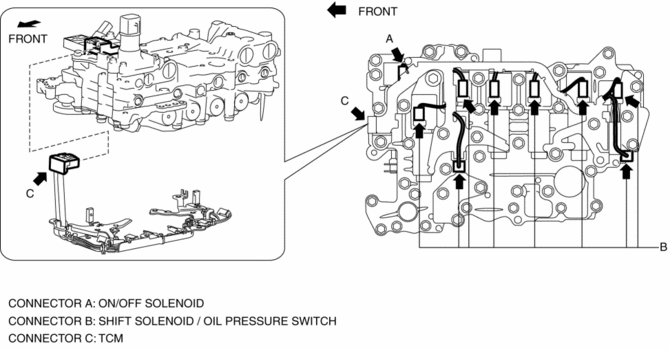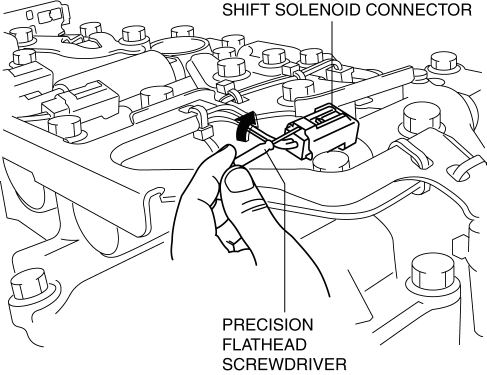Mazda CX-5 Service & Repair Manual: Coupler Component Removal/Installation [Fw6 A EL, Fw6 Ax EL]
WARNING:
-
A hot transaxle and ATF can cause severe burns. Turn off the engine and wait until they are cool.
-
Always wear protective eye wear when using the air compressor. If the air compressor is used, any particles of dirt or soiling could spatter and get into the eyes.
CAUTION:
-
Placing the control valve body connector side pointed downward could damage the control valve body connector part or sensor. If the servicing can only be performed by pointing the control valve body connector side downward, spread shock-absorbing material, which does not produce dust or foreign matter, and place the control valve body connector part and sensor on the table so that they do not directly contact the table.

1. Select the selector lever to P position.
2. Disconnect the negative battery cable..
3. Remove the front under cover No.2..
4. Clean the transaxle exterior throughout with a steam cleaner or cleaning solvents.
5. Remove the air cleaner component..
6. Remove the control valve body..
7. Remove the oil seal (control valve body)..
8. Disconnect the coupler component connectors.
CAUTION:
-
Do not scratch the shift solenoid, shift solenoid connector, oil pressure switch, and oil pressure switch connector with the precision flathead screwdriver.
-
When disconnecting connectors, grasp the connectors, not the wiring harnesses. Otherwise, the wiring harnesses may be pulled out of the connector causing poor contact.

a. Disconnect connector A and connector C by pressing the connector tab with your fingers.
b. Insert a precision flathead screwdriver and move it in the direction of the arrow to disconnect connector B as shown in the figure.

9. Remove the coupler component.

CAUTION:
-
Because there are solenoid valve securing pins in the areas circled with a dotted line shown in the figure. Always verify that the solenoid valve securing pins are on the control valve body when installing the coupler component.

10. Temporarily install the coupler component so that the oil strainer installation bolt hole does not deviate.

11. After verifying that the oil strainer installation bolt hole is not deviated, install the coupler component.
CAUTION:
-
After assembling the coupler component, verify that shift solenoids No.1, 2, 3, 4, the pressure control solenoid, and the TCC control solenoid cannot be pulled out from the control valve body.

-
Tightening torque
-
9—10 N·m {92—101 kgf·cm, 80—88 in·lbf}
12. Connect the coupler component connectors.

13. Install the control valve body..
14. Install the front under cover No.2..
15. Install the oil seal (control valve body)..
16. Install the hose clamp..
17. Connect the control valve body connector..
CAUTION:
-
Make sure that your hand does not touch the terminal as the connector terminal could be damaged.
-
Verify that there is no fluid or foreign matter adhering to the connector before connecting the connector.
-
Insert the connector straight as the connector terminal could be damaged.
-
Rotate the connector lever until a click is heard.
18. Add the ATF..
19. Install the air cleaner component..
20. Connect the negative battery cable..
21. Perform the “Mechanical System Test”..
 Control Valve Body [Fw6 A EL, Fw6 Ax EL]
Control Valve Body [Fw6 A EL, Fw6 Ax EL]
Purpose/Function
The control valve body controls the hydraulic pressure generated by the oil
pump by each solenoid valve. In addition, the oil passages which introduce hydraulic
pressure ...
 Down Switch Inspection [Fw6 A EL, Fw6 Ax EL]
Down Switch Inspection [Fw6 A EL, Fw6 Ax EL]
Continuity Inspection
NOTE:
The down switch is built into the selector lever component.
1. Disconnect the negative battery cable..
2. Remove the front console..
3. Disconnect the se ...
Other materials:
Sunvisors
When you need a sunvisor, lower it for use in front or swing it to the side.
Side Extension Sunvisors
The visor extender extends the sunvisor's range of sun shading.
To use, pull it out.
CAUTION
When moving the sunvisor, retract the visor extender to its original position.
Otherwise, ...
Rear Seat
Split Folding
The seatbacks can be folded down to provide more space in the luggage compartment.
WARNING
Tightly secure cargo in the luggage compartment when it is transported
with the seatbacks folded down:
Driving without tightly securing cargo and luggage is dangerous as it could move
and ...
Transfer Removal/Installation [Fw6 Ax EL]
CAUTION:
Performing the following procedures without first removing the front ABS
wheel-speed sensor may possibly cause an open circuit in the harness if it is
pulled by mistake. Before performing the following procedures, disconnect the
front ABS wheel-speed sensor (axle side) and ...
